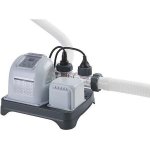What is the chemical process that takes place in an Intex Saltwater System?
The chemical process is very simple. Salt and water are combined with a low-level electrical charge inside the Saltwater System to produce Sodium Hydroxide which converts to Hypochlorous Acid. Light, in the form of sunlight, converts the Hypochlorous Acid to Hydrochloric Acid, which then reverts back to salt and water.
When copper and HClO (Hypochlorous acid)/ClO- are released into the water, these positive, surface active ions are a potent biocide. The disinfection action takes place when the positively charged copper ions form electrostatic bonds on negatively charged areas of the microorganism cell walls. {I want to interject here:even if the given explanation of how copper works as an antimicrobial is accurate ... The real disinfection/sanitation/algecidal action in a pool -saltwater or otherwise - is effected by CHLORINE, not copper. ChemGeek has explained several times, that in a pool, the undesirably high concentration of copper and it's slow disinfection time, make it unreliable for sanitation purposes.} CG: please correct or elaborate, if you feel the need  . It seems weird to me that they proffer an explanation of copper's mechanism of action, but they don't bother to explain how *chlorine* works.
. It seems weird to me that they proffer an explanation of copper's mechanism of action, but they don't bother to explain how *chlorine* works. 
This process means that the agents that eliminate bacteria and algae in the pool water are continuously produced in the Saltwater System, and when used up, revert back to plain, natural, salt and water in an ongoing cycle, never needing replacement.[all emphasis mine]{This statement is only true of the chlorine production cycle... Copper *absolutely will NOT* break down as part of the "ongoing cycle." I personally find this statement *very* misleading...  }
} Even though the water in your pool will evaporate, only the water is absorbed into the air. The salt remains in your pool. So you will need to add water occasionally, but not salt. However, if water is removed or spilled out of your pool, obviously the salt in the water is also lost. So in this instance, depending on how much water is removed from the pool, some salt may have to be added. But under normal operating conditions, salt will not need to be added.




 }
} ... I did my homework before I bought our pool, so I knew what the pump & filter, and SWG were capable of, and what they weren't. I don't expect them to be state-of-the-art... So I don't have unrealistic expectations. I think that's the biggest hurdle... Learning the limits of the Intex equipment and not expecting miracles.
... I did my homework before I bought our pool, so I knew what the pump & filter, and SWG were capable of, and what they weren't. I don't expect them to be state-of-the-art... So I don't have unrealistic expectations. I think that's the biggest hurdle... Learning the limits of the Intex equipment and not expecting miracles.